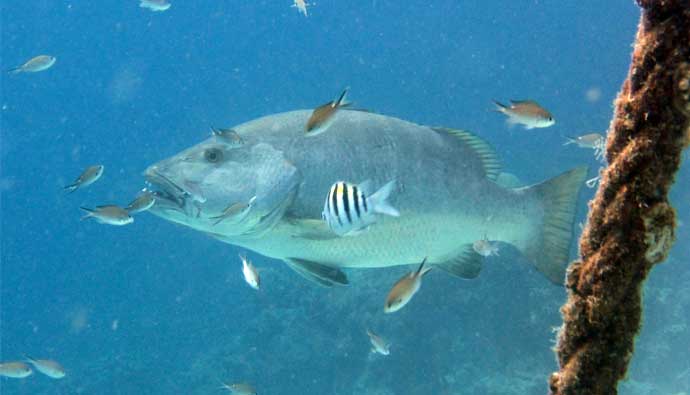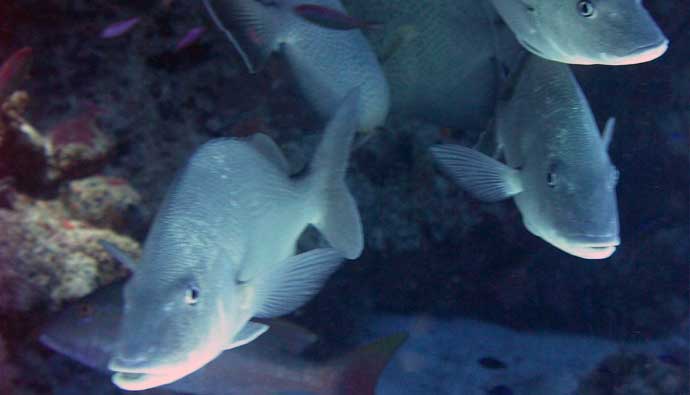Want to know how the monster cubera snapper compares to other types of snappers?
In this article, we’re going to talk about the cubera snapper. We’ll cover where it likes to hide and how you can catch it both spearfishing and with rod and reel.

Let’s get fishing!
Overview
Also known as a dog and Pacific snapper, the cubera snapper closely resembles the mangrove red snapper and other types of snapper. They are deep red in color, have four large canine teeth, blunt gill rakers, and almost the same fin shape and body shape. The young ones are purplish-brown in color, and some adults have a blue streak under the eye.
The cubera is the largest of the 9 snapper species in its range and can grow up to at least 80 pounds. It’s a strong fighter, and the snapper’s diet includes prawns, shrimp, crabs, and smaller fish.
This snapper species can be found inshore across the eastern Pacific (thus the name) from northern Mexico to the north side of Peru.
Cubera Snapper Facts
| Scientific Name: | Lutjanus cyanopterus |
| Common Name(s): | Cubera Snapper, dog, Pacific snapper, pacific dog snapper |
| Family: | Lutjanidae |
| Identifying Characteristics | The cubera fish is deep red in color and has four large canine teeth and blunt gill rakers. Young ones are purplish-brown in color, and some adults have a blue streak under the eye. |
| Depth Range | 59 to 180 ft |
| Habitat | Cubera fish can be found inshore across the eastern Pacific from northern Mexico to the north side of Peru. |
| Limits | Check your local regulations |
Cubera Snapper Habitat
Cubera snapper can be found swimming alone along reefs. The fish lives inshore or near the shore under ledges, overhangs, and rocky outcroppings over the water.
The young ones remain in sheltered mangrove areas and seagrass beds to hide from predators. Smaller cubera fish can also enter estuaries, mangroves as well as freshwater canals, and streams.
How to Catch Snapper Fish

This is NOT a light tackle fish! A cubera will fight you every inch of the way and will, in fact, speed toward rocks when it is hooked. Thus, use a braided line that is at least 80 lbs with a fluorocarbon leader of the same weight class.
Tackle that is used for marlin is strong enough to catch cubera snapper without breaking.
Cubera Snapper Fishing
Use iron jigs and other larger metal ones that will work off the bottom to catch bigger cubera snapper. Live bait made of big fish, such as skipjack tuna, can lure the fish onto the hook.
These are pretty convenient because the tuna swims right down to where the snappers congregate. You can also use feathers, plugs, and spoons to attract the fish.
Cuber Snapper Fishing Tactics
- To catch big snapper, use live lobster or jacks with 16 oz leads and a 150lb leader just off the bottom. The fish has a huge mouth and sharp canines, so it can swallow any crustacean that it can fit in its maw.
- Aggressive feeding occurs at night. To increase your chances of catching big cuberas, head out on the water four days leading up to and after a full moon.
Cubera Snapper Fishing Tips
- The biggest cuberas come for live bait so drop it right down to the bottom. If you are fishing with a lure, set the hook immediately, and start reeling!
- Allow the fish to snack on the bait for a bit, but not long enough that they eat their fill and head to the rocks.
Best Time to Catch Snapper
Cubera snapper is a solitary fish, so if you don’t fish in season, you will NOT find one.
Anglers take out their boats in March, April, July, August, November, and December, with July being the best time to catch big cuberas.

Spearfishing Cubera Snapper
If you are spearfishing for cubera snapper over a reef, make sure you are on the pressure point at the frontal edge. Plus, don’t swim out in the current and over the reef, or you will spook the snapper. Do a quick jet duck dive to catch the fish by surprise.
When a cubera snapper is speared, it fights in circles, so make sure to hold it above a structure till it starts to weaken. Tangle it in the kelp, if possible, and get your hands under the gills to secure it before landing it.
How to Clean Cubera Snapper
- Insert a sharp fillet knife at the top of the backbone, right near the head.
- Make a cut from the head to the belly right behind the gill cover and through the top fillet.
- Make a second cut by probing the length of the fish and separating the fillet from the backbone.
- Peel the cut fillet from the body and make more passes with the knife to remove it completely from the bone.
- Leave the snapper on the chopping board and slip the knife between the exposed backbone and the second/bottom fillet.
- Make repeated passes with the knife along the top of the backbone from the head right down to the tail.
- Slice away till the tail is free from the second fillet. Lift the backbone and make cuts where it is attached to the head to remove it.
How to Cook Cubera Snapper
- Place the fillets on a medium heated grill or barbecue skin side down.
- Coat with salt and pepper.
- Close the lid and allow the fish to cook in its own juices on medium heat.
- Baste the fish several times with butter, salt, and pepper mix. Do not turn the fish. It will cook on its own in 20 to 25 minutes.
- Serve with Cajun seasoning and lemon wedges.
FAQs
Big cuberas hunt for crustaceans such as lobster and crab, but their diet also includes shrimp and smaller fish.
Huge snapper can grow to about 80 pounds in weight.
Large cuberas are solitary fish, and you can find a few in peak season swimming near reefs or near rocks where they can hide if threatened. Young ones remain in mangroves or seagrass beds until they are big enough to venture out safely.
Insider Advice
Cuberas are as fierce as they look, but that is what makes them such a great sport fish.
If you are an avid angler who has snagged this monster fish, share your strategies in the comments section, and share this guide if you found it useful.




 Facebook
Facebook YouTube
YouTube









